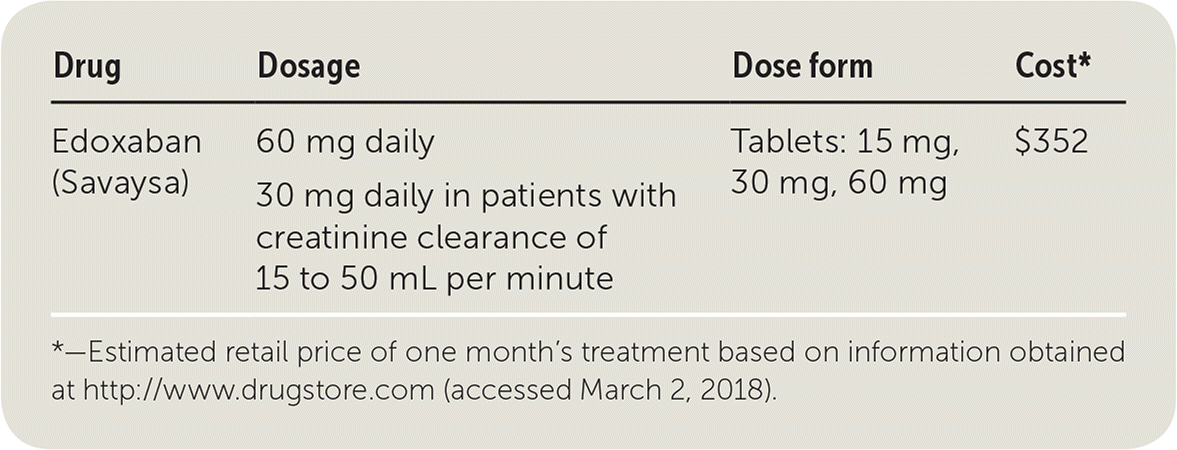
Am Fam Physician. 2018;97(8):529-530
Author disclosure: No relevant financial affiliations.
Edoxaban (Savaysa) is a once-daily, oral anticoagulant used to reduce the risk of stroke and systemic embolism in patients with nonvalvular atrial fibrillation. It is also labeled for the treatment of deep venous thrombosis and pulmonary embolism following initial parenteral anticoagulation.1 Edoxaban is one of four marketed factor Xa inhibitors, none of which requires international normalized ratio (INR) monitoring.

| Drug | Dosage | Dose form | Cost* |
|---|---|---|---|
| Edoxaban (Savaysa) | 60 mg daily 30 mg daily in patients with creatinine clearance of 15 to 50 mL per minute | Tablets: 15 mg, 30 mg, 60 mg | $352 |
Safety
Edoxaban has been compared with warfarin (Coumadin) for the prevention of stroke and systemic embolism in patients with nonvalvular atrial fibrillation. Edoxaban has a slightly lower risk of bleeding than warfarin. In clinical trials of patients with nonvalvular atrial fibrillation, major bleeding (i.e., critical, symptomatic bleeding requiring immediate treatment) occurred in 2.75% of patients receiving edoxaban vs. 3.43% receiving warfarin (hazard ratio = 0.8; 95% confidence interval [CI], 0.71 to 0.91; number needed to treat to avoid one additional episode over 2.8 years = 30; 95% CI, 17 to 82).2 Similarly, in patients treated for deep venous thrombosis and pulmonary embolism, major bleeding occurred in 8.5% of patients receiving edoxaban vs. 10.3% of those receiving warfarin over 12 months (hazard ratio = 0.81; 95% CI, 0.71 to 0.94).3 Coadministration of anticoagulants, antiplatelet agents, and thrombolytics may increase the risk of bleeding.1 There is no anticoagulant reversal agent for edoxaban. Edoxaban is 50% renally excreted, with lower blood concentrations in patients who have better renal function.1,4 Thus, in nonvalvular atrial fibrillation, edoxaban should not be prescribed in patients with a creatinine clearance greater than 95 mL per minute because of an increased risk of stroke.1,2 Edoxaban has not been studied in children, pregnant women, or nursing mothers and is a U.S. Food and Drug Administration pregnancy risk category C drug.1
Tolerability
Edoxaban is generally well-tolerated. In clinical studies, the most common reason for discontinuation of treatment was bleeding, occurring in less than 4% of patients.1 Other nonbleeding adverse reactions such as rash and abnormal results on liver function testing occurred at rates similar to warfarin.1
Effectiveness
In a trial of 21,105 patients with atrial fibrillation and a CHADS2 (congestive heart failure, hypertension, age 75 years or older, diabetes mellitus, and stroke or transient ischemic attack) score of 2 or greater, edoxaban and warfarin had similar effectiveness in the prevention of stroke or systemic embolic event, occurring in 1.18% vs. 1.50% of patients, respectively.4
In the treatment of 8,292 patients with deep venous thrombosis and pulmonary embolism who were previously treated with five to 10 days of enoxaparin (Lovenox) or unfractionated heparin, edoxaban was similar to warfarin with respect to the incidence of recurrent venous thromboembolisms (defined as a composite of deep venous thrombosis or nonfatal or fatal pulmonary embolism), 3.2% vs. 3.5%, respectively.3 No studies have directly compared edoxaban with other anticoagulants such as rivaroxaban (Xarelto), apixaban (Eliquis), betrixaban (Bevyxxa), or dabigatran (Pradaxa).
Price
At $352, the cost of a one-month supply of edoxaban is similar to that of other factor Xa inhibitors and the direct thrombin inhibitor, dabigatran, but it is significantly more expensive than warfarin, which costs about $10 for a one-month supply. This price difference may be partially offset by the elimination of laboratory INR monitoring and associated office visits.
Simplicity
Edoxaban is taken orally once daily. The recommended dosage is 60 mg daily and should be reduced to 30 mg daily in patients with moderate renal dysfunction (creatinine clearance of 15 to 50 mL per minute). Edoxaban should not be used in patients with renal failure, or in patients with nonvalvular atrial fibrillation with normal renal function (creatinine clearance greater than 95 mL per minute).1 No laboratory INR monitoring is needed.
Bottom Line
Edoxaban is an alternative to warfarin and other oral anticoagulants for the prevention of stroke in patients with nonvalvular atrial fibrillation and for the treatment of deep venous thrombosis and pulmonary embolism. It is less likely to cause significant bleeding episodes than warfarin and it does not require INR monitoring. However, it is significantly more expensive, and there is no reversal agent in the event of emergency.
